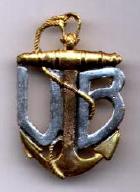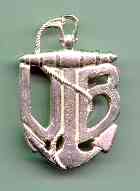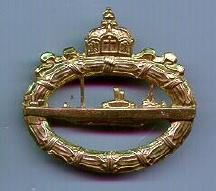|
ALBANIA- In 1960 Albania obtained 2 Whiskey class submarines from the former Soviet Union along with a submarine tender. When the Soviets were ordered out of Albania in 1961, after a political falling out, the Albanians seized two more submarines. Only two subs were kept operational and by 1980 the submarine fleet ceased to operate. It is thought that two of the boats are now operating and a third one is being used as a harbor training boat and charging station. The fourth boat has been removed and deleted from their naval lists. All boats are stationed at Sazan Island. Little is known about the Albanian sub badge as to when it is issued or the requirements for qualifications to wear. The picture showing the badge is a grey emboidery on a dark blue wool backing and was probably worn by all ranks of the submarine force on the left breast of the dress uniform. |

|
ARGENTINA- Argentina's first submarines were ordered in the late 1920s from Italy, who built three submarines. Designated as the Sante Fe Class, they served in the fleet from 1932 to 1959. In 1960 the United States sold two Ballao class boats to Argentina, but they were not modified into the Guppy configuration. In 1971, though they were replaced by two U.S. made Guppy-type boats. In 1974, two German Type 209s (1200) were delivered and assemblied at Astilleros Domecq Garcia, Buena Aires. The Salta Class consisted of the Salta and San Luis. The Santa Fe was involved and eventually damaged during the Falklands Campaign. This submarine was the first in history to be defeated by ASW helicopters. The Guppys have been removed from the active list but, the fleet still consists of The Salta Class, two Type 209s (1700), and the Santa Cruz Class. Argentina is the only South American navy to have used their submarines in an armed conflict. The Argentinian arms is appliqued on the current submarine badges. Light blue enamel at the top with white at the bottom. The Phrygian cap, in red enamel, is atop a gold staff in wreath clasped arms. The top badge is a new issue for senioir Chief Petty Officers in the Argentinian submarine force. The next badge is the current issue (from 1945 to present) for submarine officer, which comes in a polished finish (as seen to the right) or a matte finish. It is worn on the right breast pocket with pinback or clutchpin attachment. The next badge is the current issue (from 1969 to present) for enlisted submariners, which comes in a polished finish (as seen to the right) or a matte finish. It is worn on the right breast pocket with pinback or clutchpin attachment. The next badge which was introduced in 1991 is the Submarine Support Officer's badge. It is similiar to the subamrine officer badge with the exception that the arms are stamped in gold, but not filled with enamel. |

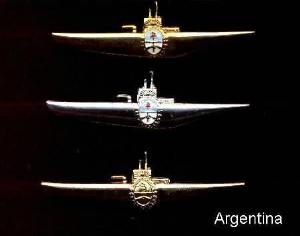
|
AUSTRALIA- Commander Henry Cook, RAN, is given a large credit to the creation of the Australian Navy Submaine Badge. The original badge was a cloth badge called the "Sausage on a Stick" or "Sausage Roll" in 1958. However, due to the general ugliness and dislike by the crews, personnel refused to wear it. Commander Cook eventually convincedd the Australian Naval Board that submariners deserved a badge that they would wear with pride. A co-worker of Commander Cook's, who was not even a submariner, by the name of Commander Alan H. MacIntosh designed the current badge. Commander Cook was given the honor and privilege of being the first officer to wear the "Dolphins" in 1966. The final British submarine based in Sydney was given these badges to wear for a year. These badges were met with great approval that the British Royal Navy used this design as a basis for their badges. The Royal Australian Navy submarine badge is worn by all qualified ranks over the left pocket or medal bar. It is a blue plain shield supported by two dolphins and topped by a Queen's crown. It is a clutch pin attachment. The miniature version of the RAN submariner's badge is worn with mess dress. It is a clutch pin attachment. The cloth version of RAN submarine badge is an colored emboidery on a dark blue backing. It is worn on coveralls and working uniforms. It is not considered an official badge, but it condoned within the submarine squadron. |
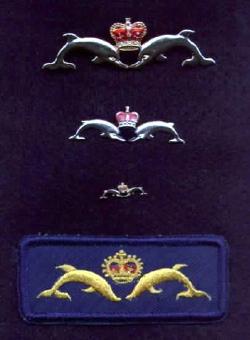
|
AUSTRIA- Even though Austria and Hungary are currently landlocked, until 1918 the Austro-Hungarian Empire consisted of a great deal of Yugoslavia and Romania. Austria-Hungary's prinicipal naval bases were on the Adriatic sea in Pola and Fiume in present -day Croatia. Pola was the main submarine base for the approximately twenty submarines of the U-Boat fleet as well as the submarine vessels of the Kaiserliche Marine. The top badge was authorized on April 15, 1910. It is the first original submarine crew member's badge which came with a spring clip attachment. They were of solid construction, made with silver colered Thio-metal. During World War I, a pin back arrangement was used. It is worn on the left pocket or below. It is authorized and worn by all ranks. The next badge is a privately made version of the original badge. It was also worn on or below the left pocket. The next badge can also be seen on the Germany information page since it was awarded to Austrian submariners as well as Imperial German ones during their alliance. The Imperial Navy, U-Boat War Badge dates back to 1918. It is a tall-masted WW1 submarine sailing sinister surrounded by a wrapped oval wreath with a Hohenzollen crown atop of the badge. It is gold metal and worn on or below the left pocket. |
